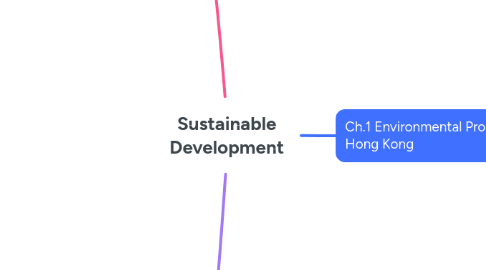
1. Ch.3 The Role of Individuals in Achieving Sustainable Development
1.1. Responsibilities of Different Stakeholders
1.1.1. Government
1.1.1.1. Establishment of definitions and principles
1.1.1.2. Formulation of development strategies
1.1.1.3. Priority to allocation of work and resources
1.1.1.4. Assessment of environmental impact
1.1.1.5. Assessment of social impact
1.1.1.6. Formulation and implementation of policies
1.1.2. Corporations
1.1.2.1. Bearing the corporate social responsibility (CSR)
1.1.2.1.1. Sustainable production
1.1.2.1.2. Reducing pollution
1.1.2.1.3. Evaluating influences on the environment
1.1.2.1.4. Promoting environmental protection work
1.1.3. Non-governmental organizations
1.1.3.1. Monitoring the government, the business sector and society
1.1.3.2. Promoting the concept of sustainable development
1.1.3.3. Co-organizing environmental protection activities with other sectors
1.1.4. Public
1.1.4.1. Complying with the principles of sustainable consumption
1.1.4.1.1. following 5R Principle
1.1.4.2. Saving energy
1.1.4.3. Participation in environmental protection activities
1.1.4.4. Being concerned about social issues
2. Ch.2 The Idea of Sustainable Development and its Influencing Factors
2.1. The Definition and Dimensions of Sustainable Development
2.1.1. **Definition** of sustainable development
2.1.1.1. the development that meets the needs of the present without compromising the ability of future generations to meet their own needs.
2.1.2. **Three dimensions** of sustainable development
2.1.2.1. Economic
2.1.2.2. Environmental
2.1.2.3. Social
2.2. The Vales and Principles of Sustainable Development
2.2.1. Three related principles of sustainable development
2.2.1.1. Peace
2.2.1.2. Equity
2.2.1.2.1. Intra-generation equity
2.2.1.2.2. Inter-generation equity
2.2.1.3. Conservation
2.3. Factors affecting Sustainable Development
2.3.1. Science and technology
2.3.1.1. scientific and technological development
2.3.1.2. people's understanding about the environment
2.3.2. Socio-economic
2.3.2.1. materialism and consumerism of modern people
2.3.2.2. different pursuits in quality of life
2.3.3. Political
2.3.3.1. countries with different levels of development have different attitudes towards sustainable development
2.3.3.2. different degrees of Economic, Scientific and Humanitarian Development
2.3.4. Cultural
2.3.4.1. different cultures and moral considerations are associated with different perceptions towards sustainable development
3. Ch.1 Environmental Problems in Hong Kong
3.1. New Directions in Energy Application
3.1.1. Non-renewable
3.1.1.1. Nuclear Energy
3.1.1.1.1. - made from uranium ore - electricity is generated by powering large turbines by the heat produced by the nuclear reaction - The use of Nuclear Energy accounted for about 4.4% of Global Electricity Supply in 2018
3.1.1.1.2. advantages
3.1.1.1.3. disadvantages
3.1.1.2. Shale Gas
3.1.1.2.1. - increase of excavation works due to the breakthrough of the excavation technology of shale gas - rich reserve
3.1.1.2.2. advantages
3.1.1.2.3. disadvantages
3.1.1.3. Combustible ice
3.1.1.3.1. - a solid substance formed by natural gas and water - appearance is similar to ice - has not been commercially excavated yet as it was discovered later than other sources of energy
3.1.1.3.2. advantages
3.1.1.3.3. disadvantages
3.1.2. Renewable
3.1.2.1. Hydro Energy
3.1.2.1.1. - uses the amount of water flow and the difference in water level to power the turbine when generating electricity - built in countries with rich water resources
3.1.2.1.2. advantages
3.1.2.1.3. disadvantages
3.1.2.2. Solar Energy
3.1.2.2.1. - is divided into thermal and photovoltaic energy - Its ratio to Global Energy Use still remains low since the power generation of Solar Energy cannot satisfy the electricity demand on its own.
3.1.2.2.2. advantages
3.1.2.2.3. disadvantages
3.1.2.3. Wind Energy
3.1.2.3.1. - uses wind to power the generator - mainly distributed and placed in coastal and Northern Inland Areas
3.1.2.3.2. advantages
3.1.2.3.3. disadvantages
3.1.2.4. Geothermal Energy
3.1.2.4.1. - produced by the heat of the earth's crust near the core - After the ‘Enhanced Geothermal System’ was developed, Geothermal Energy increases its efficiency
3.1.2.4.2. advantages
3.1.2.4.3. disadvantages
3.1.2.5. Biomass Energy
3.1.2.5.1. - produced by chemical processes (combustion, fermentation, decomposition) and turning organic matter into biofuel - the 4th largest energy source in the world
3.1.2.5.2. advantages
3.1.2.5.3. disadvantages
3.2. Historical Development of Human Use of Energy
3.2.1. Non-renewable energy
3.2.1.1. the supply and the reserves are limited
3.2.1.2. most of the non-renewable energy are fossil fuels (oil, coal, natural gas)
3.2.2. Renewabe energy
3.2.2.1. can be constantly obtained from nature
3.2.2.2. the supply is unlimited
3.3. The Major Environmental Problems in Hong Kong
3.3.1. Waste Problem
3.3.1.1. Different type of waste
3.3.1.1.1. Special waste
3.3.1.1.2. Construction waste
3.3.1.1.3. Municipal solid waste (MSW)
3.3.1.2. Three strategic landfills
3.3.1.2.1. West New Territories (WENT) Landfill
3.3.1.2.2. South East New Territories (SENT) Landfill
3.3.1.2.3. North East New Territories (NENT) Landfill
3.3.2. Air Pollution
3.3.2.1. Smog
3.3.2.1.1. a prevalent type of air pollution which reduces visibility
3.3.2.1.2. occurs when emissions from combusting fossil fuels react with sunlight
3.3.2.2. Air pollutants (lead to air pollution)
3.3.2.2.1. PM2.5 Particulate
3.3.2.2.2. Sulphur dioxide
3.3.2.2.3. Nitrogen dioxide
3.3.2.3. Greenhouse gases (lead to global warming)
3.3.2.3.1. carbon dioxide
3.3.2.3.2. methane
3.3.2.3.3. nirtrous oxide
3.3.2.3.4. fluorinated gases
3.3.2.4. Air Quality Health Index
3.3.2.4.1. purpose
3.3.2.4.2. useful for
3.3.2.5. Impact
3.3.2.5.1. Health problem
3.3.2.5.2. Environmental problem
3.3.2.6. Suggestions
3.3.2.6.1. wear good quality masks
3.3.2.6.2. install an air purifier at home
3.3.3. Energy Use
3.3.3.1. energy consumption increases as the population increases
3.3.3.2. Type of Energy
3.3.3.2.1. Primary Energy
3.3.3.2.2. Secondary Energy
3.3.3.3. Electricity Suppliers in Hong Kong
3.3.3.3.1. CLP Power Hong Kong Limited (CLP Power)
3.3.3.3.2. Hong Kong Electric Company Limited (HEC)
3.3.3.4. Impact
3.3.3.4.1. Environmental problems
3.3.3.5. Limits of Energy
3.3.3.5.1. Fossil fuels are limited
